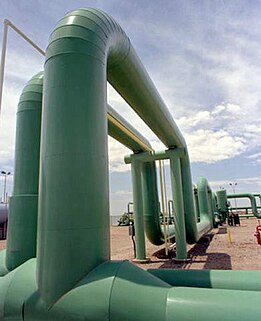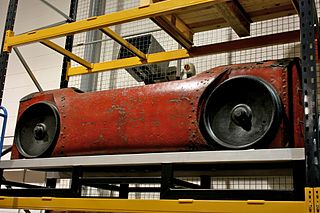 W
WPipeline transport is the long-distance transportation of a liquid or gas through a system of pipes—a pipeline—typically to a market area for consumption. The latest data from 2014 gives a total of slightly less than 2,175,000 miles (3,500,000 km) of pipeline in 120 countries of the world. The United States had 65%, Russia had 8%, and Canada had 3%, thus 75% of all pipeline were in these three countries.
 W
WHydrogen pipeline transport is a transportation of hydrogen through a pipe as part of the hydrogen infrastructure.
 W
WThe London Pneumatic Despatch Company was formed on 30 June 1859, to design, build and operate an underground railway system for the carrying of mail, parcels and light freight between locations in London. The system was used between 1863 and 1874.
 W
WMagnetic flux leakage is a magnetic method of nondestructive testing that is used to detect corrosion and pitting in steel structures, most commonly pipelines and storage tanks. The basic principle is that a powerful magnet is used to magnetize the steel. At areas where there is corrosion or missing metal, the magnetic field "leaks" from the steel. In an MFL tool, a magnetic detector is placed between the poles of the magnet to detect the leakage field. Analysts interpret the chart recording of the leakage field to identify damaged areas and to estimate the depth of metal loss.
 W
WThe Paris pneumatic post was a pneumatic tube message-carrying service that operated in the French capital from 1866. It was established because of the popularity of the electric telegraph in the city which had led to the signal cables becoming overloaded and messages being sent by road. The pneumatic system allowed the telegraph companies to send messages underground through sealed lines laid in the Paris sewers, bypassing any traffic on the roads above. The network was taken into public ownership in 1879, under the Ministry of Posts and Telegraphs, and opened to messages sent by the general public. Messages continued to be considered officially as telegrams and for a fixed cost users could write a message on a "petit bleu" form to be sent anywhere in the city. After arriving at the office nearest the recipient it would be taken to their address by a courier.
 W
WIn pipeline transportation, pigging is the practice of using pipeline inspection gauges, devices generally referred to as pigs or scrapers, to perform various maintenance operations. This is done without stopping the flow of the product in the pipeline.
 W
WA pipeline bridge is a bridge for running a pipeline over a river or another obstacle. Pipeline bridges for liquids and gases are, as a rule, only built when it is not possible to run the pipeline on a conventional bridge or under the river. However, as it is more common to run pipelines for centralized heating systems overhead, for this application even small pipeline bridges are common.
 W
WPneumatic tubes are systems that propel cylindrical containers through networks of tubes by compressed air or by partial vacuum. They are used for transporting solid objects, as opposed to conventional pipelines, which transport fluids. Pneumatic tube networks gained acceptance in the late 19th and early 20th centuries for offices that needed to transport small, urgent packages over relatively short distances. Some installations grew to significant complexity, but were mostly superseded. In some settings, such as hospitals, they remain widespread and have been further extended and developed in the 21st century.
 W
WThe Prague pneumatic post is the world's last preserved municipal pneumatic post system. It is an underground system of metal tubes under the wider centre of Prague, totaling about 55 kilometres (34 mi) in length. The system started service in 1889 and remained in use by the government, banks and the media until it was rendered inoperative by the August 2002 European floods.
 W
WThe Rohrpost in Berlin, was a pneumatic tube postal service, which existed from 18 November 1865 until 1963 in West Berlin and in East Berlin until 1976.
 W
WA slurry pipeline is a specially engineered pipeline used to move ores, such as coal or iron, or mining waste, called tailings, over long distances. A mixture of the ore concentrate and water, called slurry, is pumped to its destination and the water is filtered out. Due to the abrasive properties of slurry, the pipelines can be lined with high-density polyethylene (HDPE), or manufactured completely from HDPE Pipe, although this requires a very thick pipe wall. Slurry pipelines are used as an alternative to railroad transportation when mines are located in remote, inaccessible areas.
 W
WThe Tolt pipeline runs from the Tolt Reservoir in the Cascade Range to the Lake Forest Park Reservoir, owned by the City of Seattle, supplying the city with about 30% of its water supply. It passes through Seattle's northern Eastside suburbs and also supplies several suburban cities and water districts.
 W
WWood lagging is a method of banding wooden slats around pipelines to protect against impact, abrasion, and corrosion. Wooden lagging acts as a sheath, protecting the pipeline from damage, and is especially useful in rocky terrain; steep inclines; around rivers or swampy areas; and other rough terrain. Boiler lagging is akin to pipe lagging, but is used to protect steam boilers.